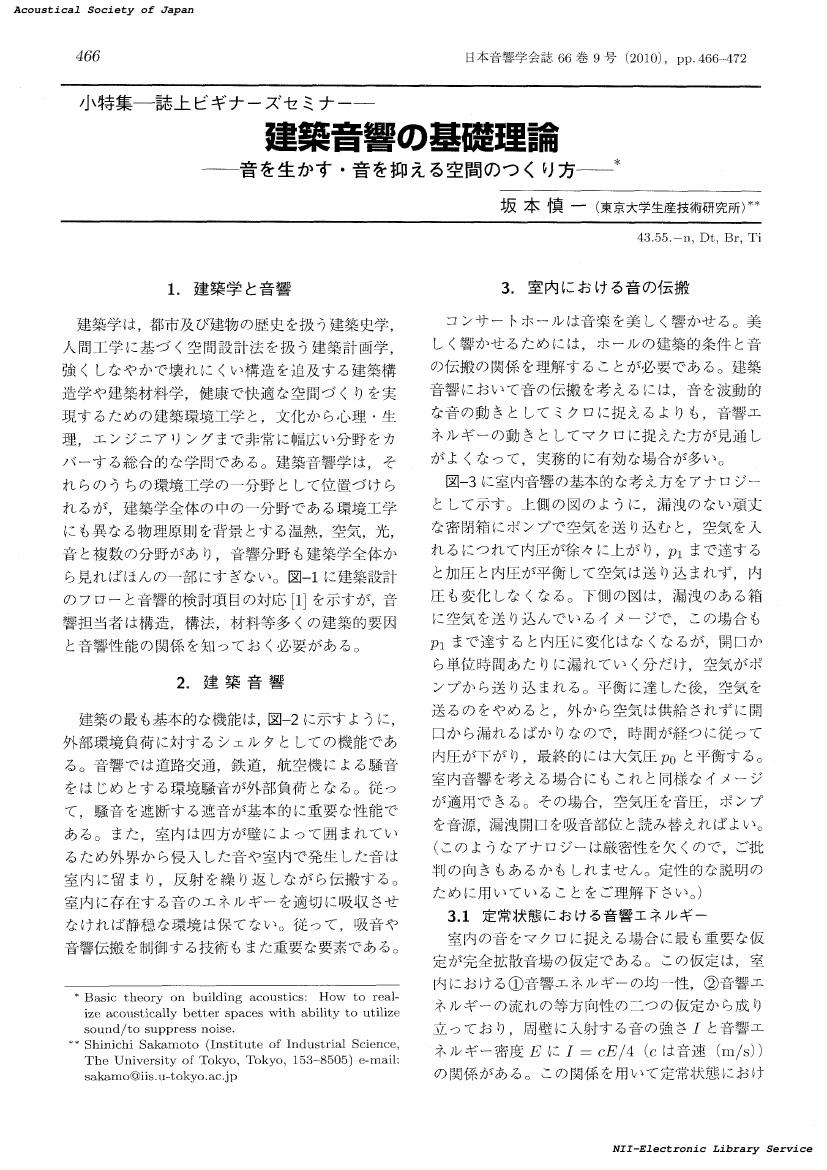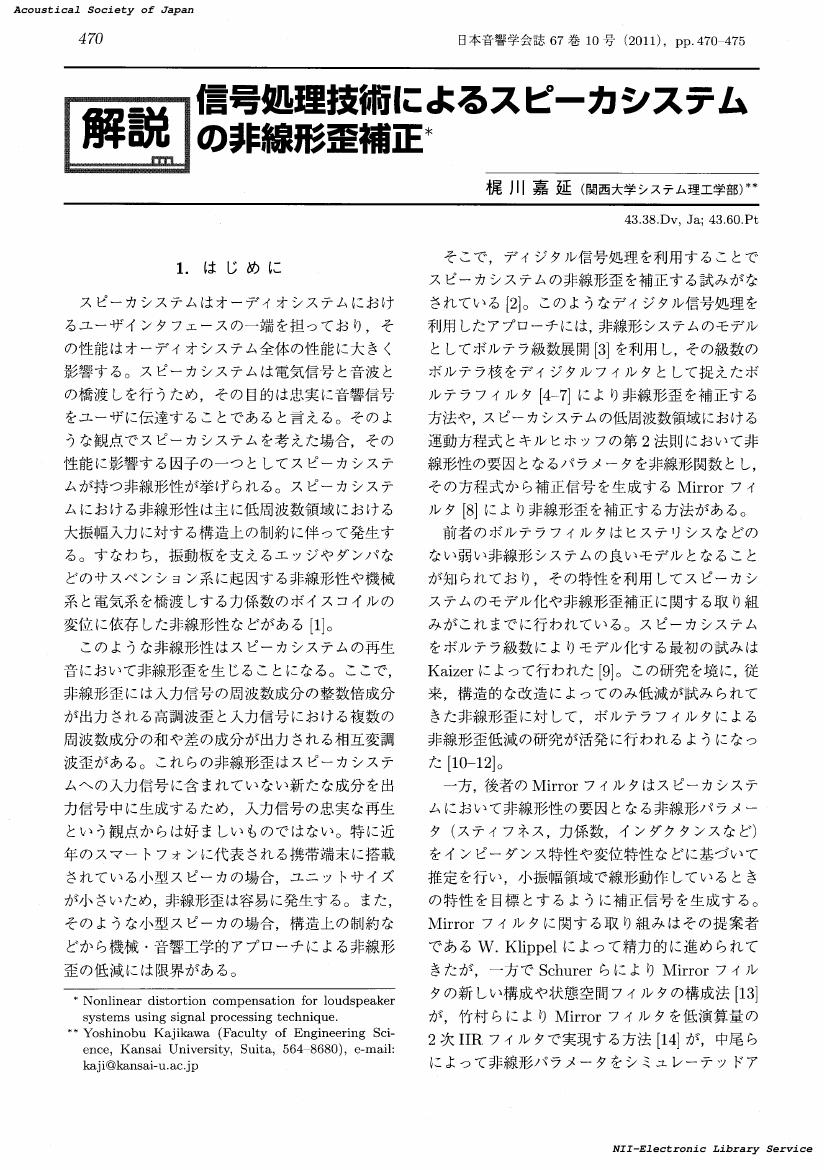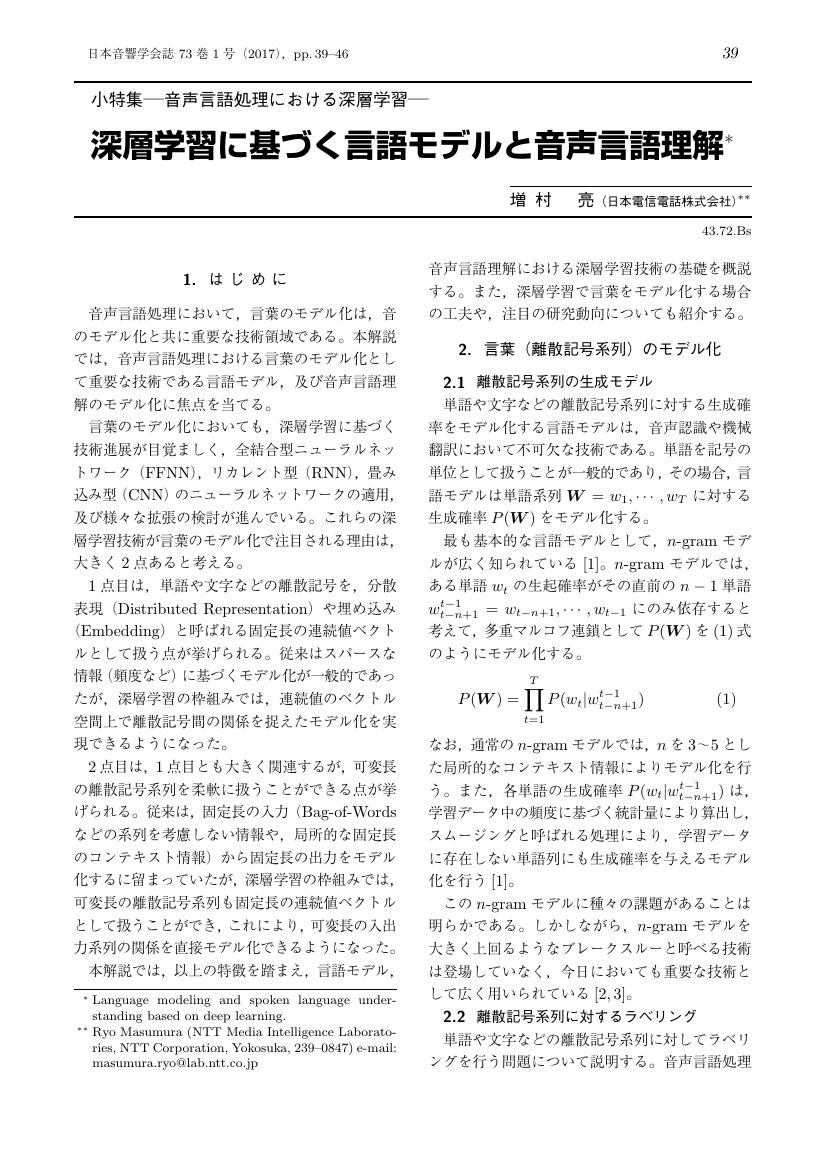- 著者
- 小野 一穂
- 出版者
- 一般社団法人 日本音響学会
- 雑誌
- 日本音響学会誌 (ISSN:03694232)
- 巻号頁・発行日
- vol.64, no.11, pp.656-660, 2008
- 参考文献数
- 12
1 0 0 0 OA AM ステレオ放送
- 著者
- 稲富 抱一
- 出版者
- 一般社団法人 日本音響学会
- 雑誌
- 日本音響学会誌 (ISSN:03694232)
- 巻号頁・発行日
- vol.38, no.6, pp.370-374, 1982-06-01 (Released:2017-06-02)
- 著者
- 坂本 慎一
- 出版者
- 一般社団法人 日本音響学会
- 雑誌
- 日本音響学会誌 (ISSN:03694232)
- 巻号頁・発行日
- vol.66, no.9, pp.466-472, 2010-09-01 (Released:2017-06-02)
- 参考文献数
- 10
1 0 0 0 OA 小特集「物理モデルによる楽器音の合成」にあたって
- 著者
- 森 太郎 西口 磯春
- 出版者
- 一般社団法人 日本音響学会
- 雑誌
- 日本音響学会誌 (ISSN:03694232)
- 巻号頁・発行日
- vol.65, no.9, pp.477-478, 2009-09-01 (Released:2017-06-02)
- 参考文献数
- 5
1 0 0 0 OA TC 43(音響)本体の規格審議の動向について
1 0 0 0 OA 筋電位計測装置
- 著者
- 大田 健紘
- 出版者
- 一般社団法人 日本音響学会
- 雑誌
- 日本音響学会誌 (ISSN:03694232)
- 巻号頁・発行日
- vol.72, no.9, pp.574-575, 2016-09-01 (Released:2017-07-01)
- 参考文献数
- 1
1 0 0 0 OA 低周波音の評価について
- 著者
- 時田 保夫
- 出版者
- 一般社団法人 日本音響学会
- 雑誌
- 日本音響学会誌 (ISSN:03694232)
- 巻号頁・発行日
- vol.41, no.11, pp.806-812, 1985-11-01 (Released:2017-06-02)
- 被引用文献数
- 1
1 0 0 0 OA 諸外国における風車騒音に関するガイドライン
- 著者
- 橘 秀樹
- 出版者
- 一般社団法人 日本音響学会
- 雑誌
- 日本音響学会誌 (ISSN:03694232)
- 巻号頁・発行日
- vol.71, no.4, pp.198-205, 2015-04-01 (Released:2017-06-02)
- 被引用文献数
- 2
1 0 0 0 OA 環境音分析の研究動向
- 著者
- 井本 桂右
- 出版者
- 一般社団法人 日本音響学会
- 雑誌
- 日本音響学会誌 (ISSN:03694232)
- 巻号頁・発行日
- vol.75, no.9, pp.512-518, 2019-09-01 (Released:2020-03-01)
- 参考文献数
- 66
1 0 0 0 OA 統計的手法による音響イベント検出
- 著者
- 林 知樹 戸田 智基
- 出版者
- 一般社団法人 日本音響学会
- 雑誌
- 日本音響学会誌 (ISSN:03694232)
- 巻号頁・発行日
- vol.75, no.9, pp.532-537, 2019-09-01 (Released:2020-03-01)
- 参考文献数
- 48
1 0 0 0 OA 深層学習に基づく音源分離
- 著者
- 亀岡 弘和
- 出版者
- 一般社団法人 日本音響学会
- 雑誌
- 日本音響学会誌 (ISSN:03694232)
- 巻号頁・発行日
- vol.75, no.9, pp.525-531, 2019-09-01 (Released:2020-03-01)
- 参考文献数
- 23
1 0 0 0 OA 音声認識における音響モデル(<小特集>自動音声認識研究の動向と展望)
- 著者
- 渡部 晋治
- 出版者
- 一般社団法人 日本音響学会
- 雑誌
- 日本音響学会誌 (ISSN:03694232)
- 巻号頁・発行日
- vol.66, no.1, pp.18-22, 2009-12-25 (Released:2017-06-02)
- 参考文献数
- 63
1 0 0 0 OA 鼻子音の識別
- 著者
- 重永 実 有泉 均
- 出版者
- 一般社団法人 日本音響学会
- 雑誌
- 日本音響学会誌 (ISSN:03694232)
- 巻号頁・発行日
- vol.21, no.5, pp.263-271, 1965-09-30 (Released:2017-06-02)
A method of recognizing /m/ and /n/ of monosyllables and words in real time is reported. The method consists of three parts; segmentation of nasal consonants, recognition of the following vowel, and discrimination between /m/ and /n/ according to the result of vowel recognition. In order to extract the nasal part, /e, a, o, u, w/ are excluded from nasals by comparing the output of 300 c/s LPF with that of 500〜1600 c/s BPF, and /i, j/ are excluded by comparing 500〜1600 c/s with 2800〜5000 c/s. Voiceless stops are easily omitted by comparing the output of 300 c/s LPF with that of 700 c/s HPF, and this circuit is also used for excluding vowels. In order to exclude the beginning and end part of /u/ more certainly, the output wave form of 400〜1000 c/s BPF is used. The parts in which the envelope of that wave varies rapidly are excluded from the nasal part. For excluding voiced stops, fricatives, and flappeds, fundamental frquency components are extracted from filtering output of 400〜1000 c/s BPF and the parts in which the fundamental frequency components exist continuously are considered to be likely nasal. The low intensity parts of original speech waves are considered to be non-nasal parts. The segment which satisfies above six conditions is decided to be nasal consonant after leaving out 12 msec of the continuum. According to this method the initial part of the nasal consonant is often missed but the boundary between the nasal consonant and the following vowel is pointed out exactly. Concerning about the discrimination between /m/ and /n/, the components of two specific frequencies are compared just before the boundary between the nasal consonant and the following vowel for distinguishing /mi/ and /me/ from /ni/ and /ne/ respectively. For the nasals followed by /a, o, u/, F_2 loci are used directly. Though /me/ and /ne/ in words are not discriminated satisfactorily by the method due to the individual variations, the others are recognized correctly over 80% for 180 samples of three male speakers.
1 0 0 0 OA 英語が話せる日本人, 話せない日本人(<小特集>外国語をはなそう!)
- 著者
- 河合 剛
- 出版者
- 一般社団法人 日本音響学会
- 雑誌
- 日本音響学会誌 (ISSN:03694232)
- 巻号頁・発行日
- vol.55, no.1, pp.45-50, 1998-12-25 (Released:2017-06-02)
- 被引用文献数
- 1
- 著者
- 谷口 高士
- 出版者
- 一般社団法人 日本音響学会
- 雑誌
- 日本音響学会誌 (ISSN:03694232)
- 巻号頁・発行日
- vol.62, no.9, pp.682-687, 2006
- 参考文献数
- 10
1 0 0 0 OA 信号処理技術によるスピーカシステムの非線形歪補正
- 著者
- 梶川 嘉延
- 出版者
- 一般社団法人 日本音響学会
- 雑誌
- 日本音響学会誌 (ISSN:03694232)
- 巻号頁・発行日
- vol.67, no.10, pp.470-475, 2011-10-01 (Released:2017-06-02)
- 参考文献数
- 28
1 0 0 0 OA 深層学習に基づく言語モデルと音声言語理解
- 著者
- 増村 亮
- 出版者
- 一般社団法人 日本音響学会
- 雑誌
- 日本音響学会誌 (ISSN:03694232)
- 巻号頁・発行日
- vol.73, no.1, pp.39-46, 2017 (Released:2017-07-01)
- 参考文献数
- 88
1 0 0 0 OA 建築物における風による音の発生とその防止
- 著者
- 北村 敏也 林 芳成 山田 聡 宮田 勝文 山田 伸志
- 出版者
- 一般社団法人 日本音響学会
- 雑誌
- 日本音響学会誌 (ISSN:03694232)
- 巻号頁・発行日
- vol.61, no.10, pp.597-603, 2005-10-01 (Released:2017-06-02)
1 0 0 0 OA サンバ演奏の動作解析(<小特集>音楽演奏者の動作解析)
- 著者
- 藤波 努
- 出版者
- 一般社団法人 日本音響学会
- 雑誌
- 日本音響学会誌 (ISSN:03694232)
- 巻号頁・発行日
- vol.67, no.9, pp.427-432, 2011-09-01 (Released:2017-06-02)
- 参考文献数
- 7
- 著者
- 河原 英紀
- 出版者
- 一般社団法人 日本音響学会
- 雑誌
- 日本音響学会誌 (ISSN:03694232)
- 巻号頁・発行日
- vol.59, no.11, pp.670-675, 2003
- 参考文献数
- 42
- 被引用文献数
- 2












